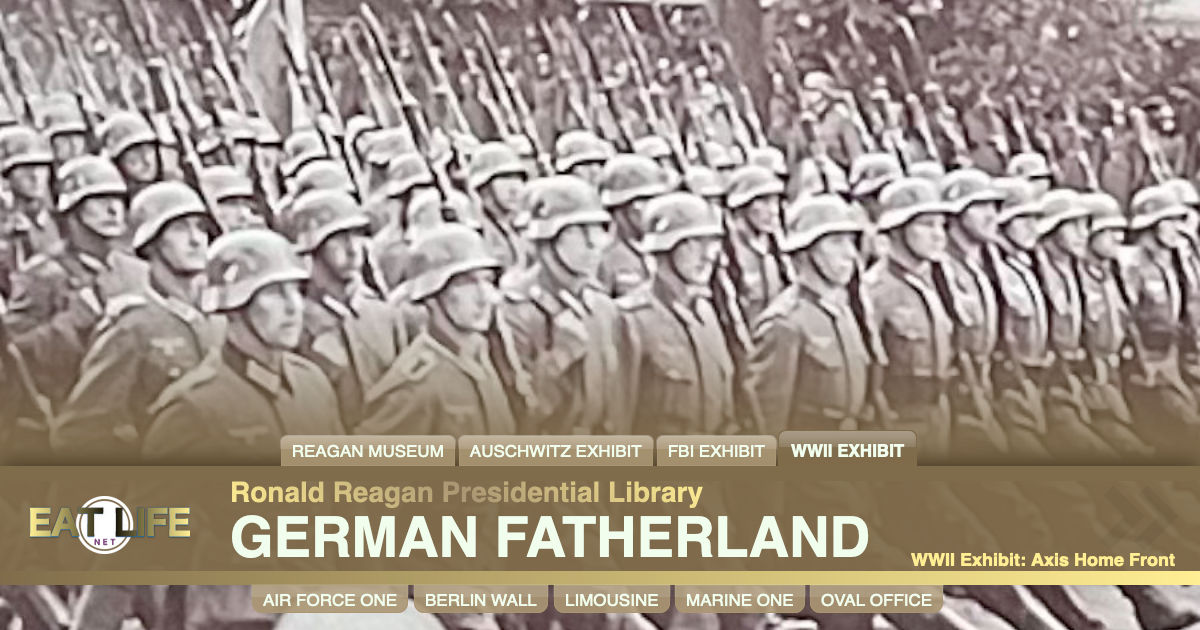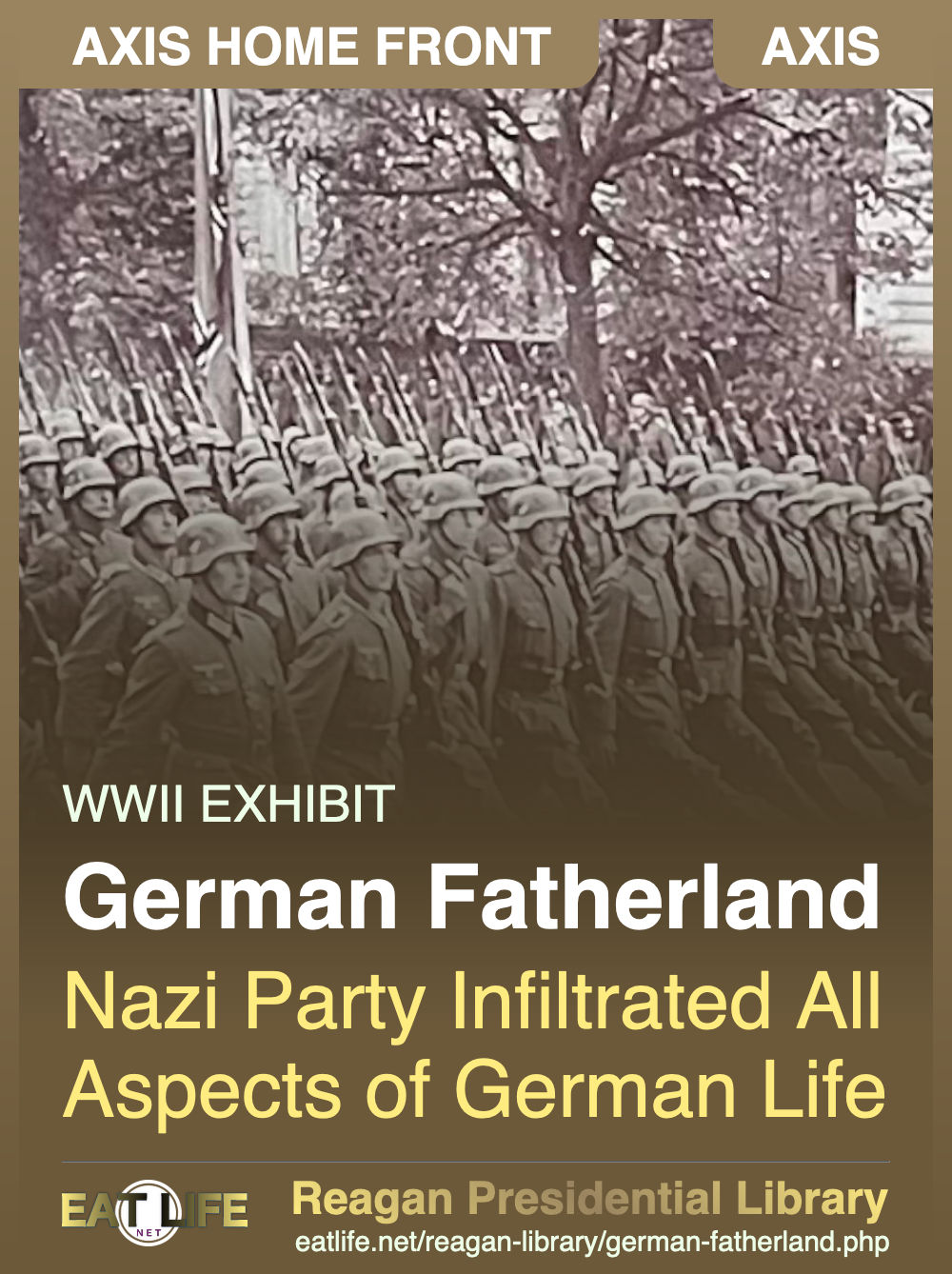The Nazi party infiltrated all aspects of German life. All clubs and organizations were co-opted or replaced with Nazi equivalents. Every non-Jewish boy was required to join the Hitler Youth. All other youth groups, including the Boy Scouts, were banned. Sports groups were taken over. Hitler combined several women's leagues into one official Nazi Women's Organization. It had 2 million members by 1938. They even encouraged German women to have multiple children to increase the Aryan population.
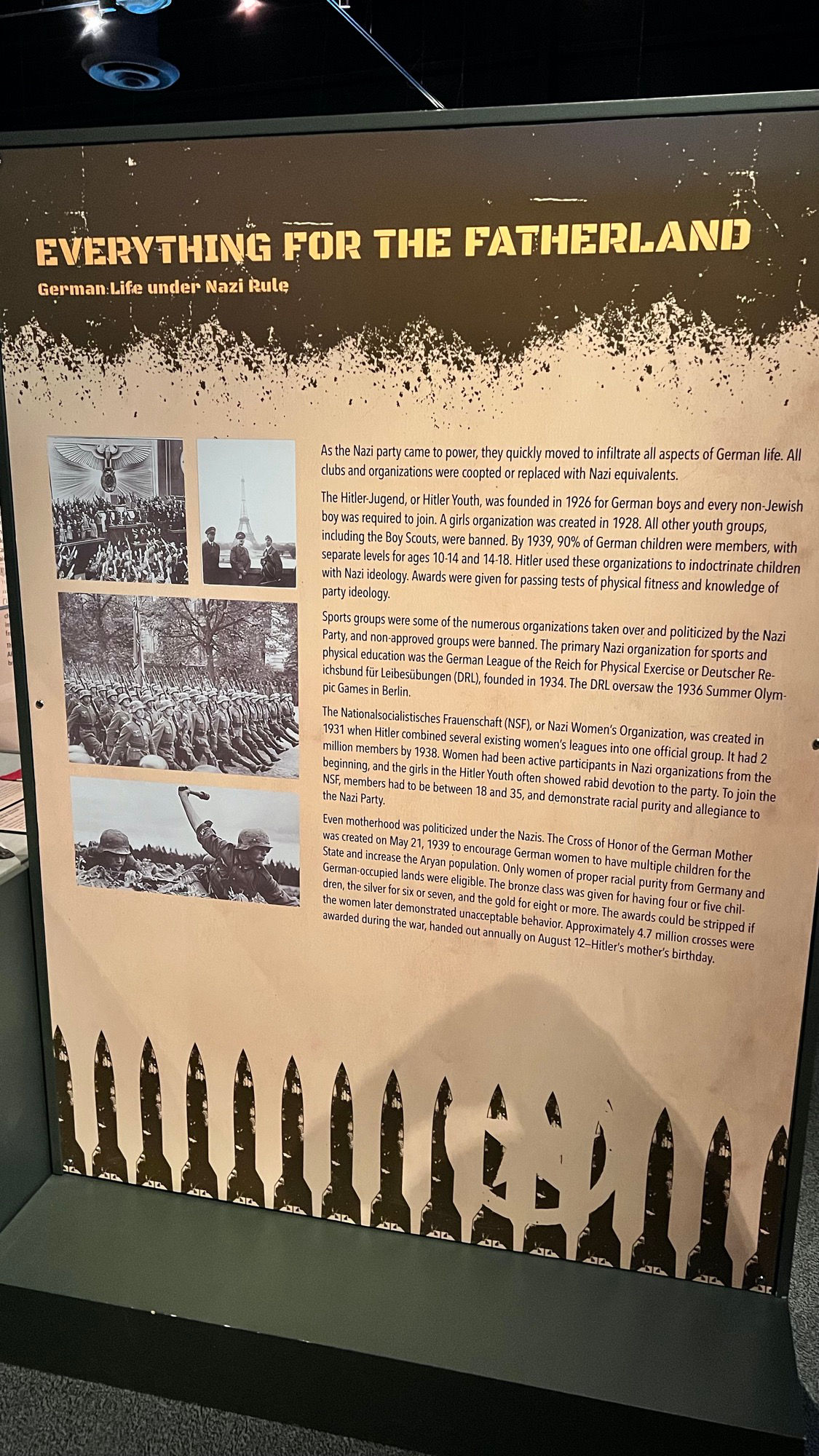
German Life under Nazi Rule
As the Nazi party came to power, they quickly moved to infiltrate all aspects of German life. All clubs and organizations were co-opted or replaced with Nazi equivalents.
The Hitler-Jugend, or Hitler Youth, was founded in 1926 for German boys and every non-Jewish boy was required to join. A girls organization was created in 1928. All other youth groups, including the Boy Scouts, were banned. By 1939, 90% of German children were members, with separate levels for ages 10-14 and 14-18. Hitler used these organizations to indoctrinate children with Nazi ideology. Awards were given for passing tests of physical fitness and knowledge of party ideology.
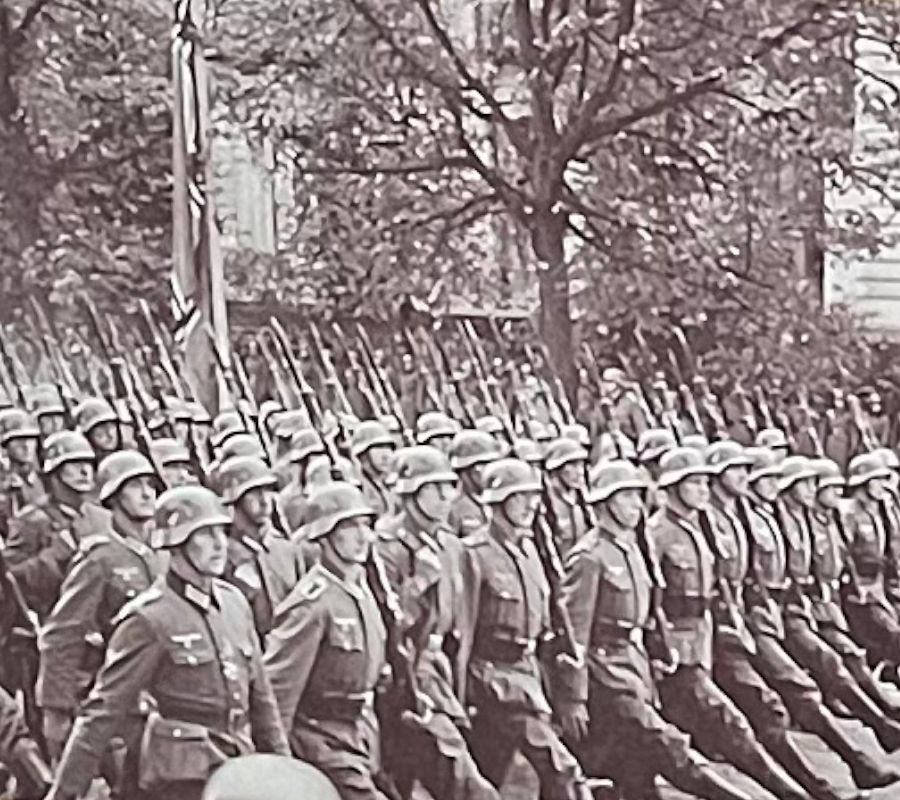 Sports groups were some of the numerous organizations taken over and politicized by the Nazi Party, and non-approved groups were banned.
The primary Nazi organization for sports and physical education was the German League of the Reich for Physical Exercise or Deutscher Reichsbund für Leibesübungen (DRL), founded in 1934.
The DRL oversaw the 1936 Summer Olympic Games in Berlin.
Sports groups were some of the numerous organizations taken over and politicized by the Nazi Party, and non-approved groups were banned.
The primary Nazi organization for sports and physical education was the German League of the Reich for Physical Exercise or Deutscher Reichsbund für Leibesübungen (DRL), founded in 1934.
The DRL oversaw the 1936 Summer Olympic Games in Berlin.
The Nationalsozialistische Frauenschaft (NSF), or Nazi Women's Organization, was created in 1931 when Hitler combined several existing women's leagues into one official group. It had 2 million members by 1938. Women had been active participants in Nazi organizations from the beginning, and the girls in the Hitler Youth often showed rabid devotion to the party. To join the NSF, members had to be between 18 and 35, and demonstrate racial purity and allegiance to the Nazi Party.
Even motherhood was politicized under the Nazis.
The Cross of Honor of the German Mother was created on May 21, 1939 to encourage German women to have multiple children for the State and increase the Aryan population.
Only women of proper racial purity from Germany and German-occupied lands were eligible.
- The bronze class was given for having four or five children
- the silver for six or seven
- the gold for eight or more
The awards could be stripped if the women later demonstrated unacceptable behavior. Approximately 4.7 million crosses were awarded during the war, handed out annually on August 12 - Hitler's mother's birthday.
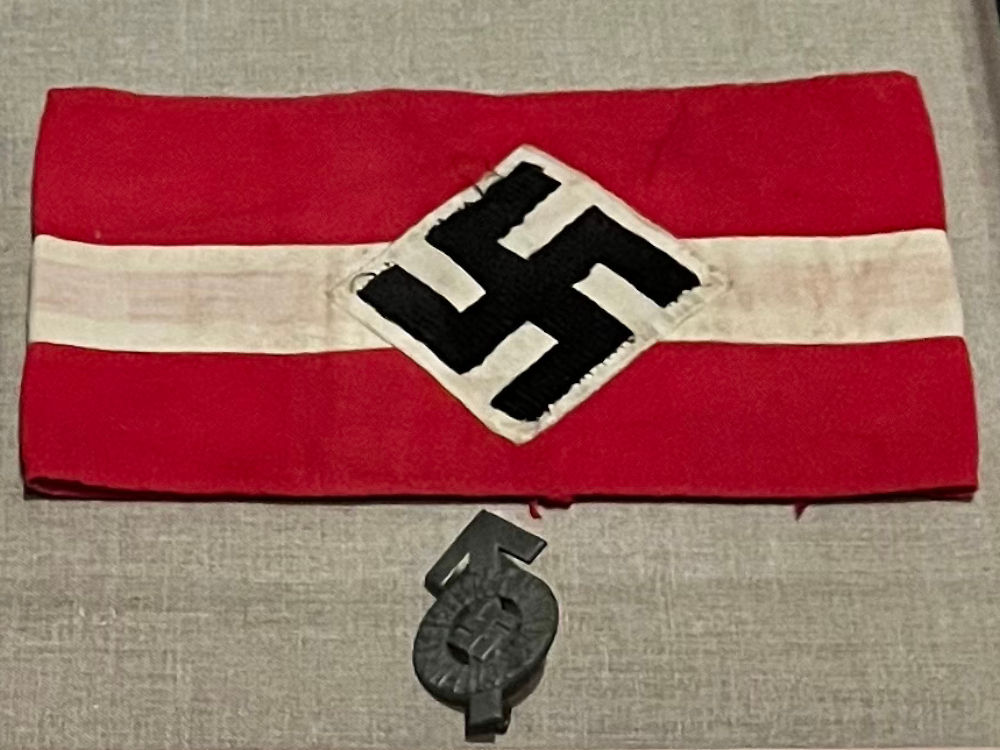
1935-1945
The Hitler Jugend, or Hitler Youth, was founded in 1926 for German boys and every non-Jewish boy was required to join. There were separate levels for boys ages 10-14 and 14-18. Awards were given out for passing tests of physical fitness and knowledge of Nazi ideology.
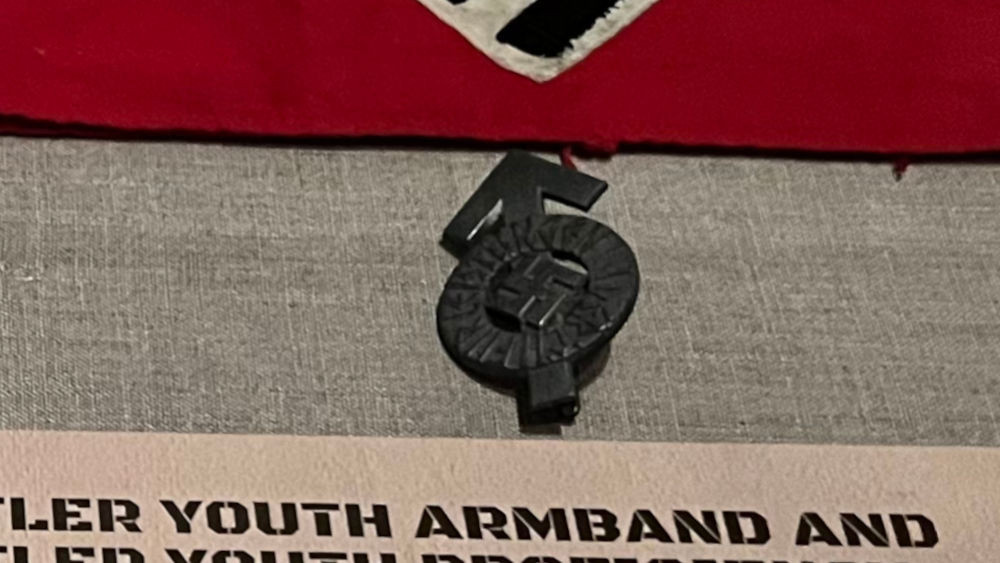
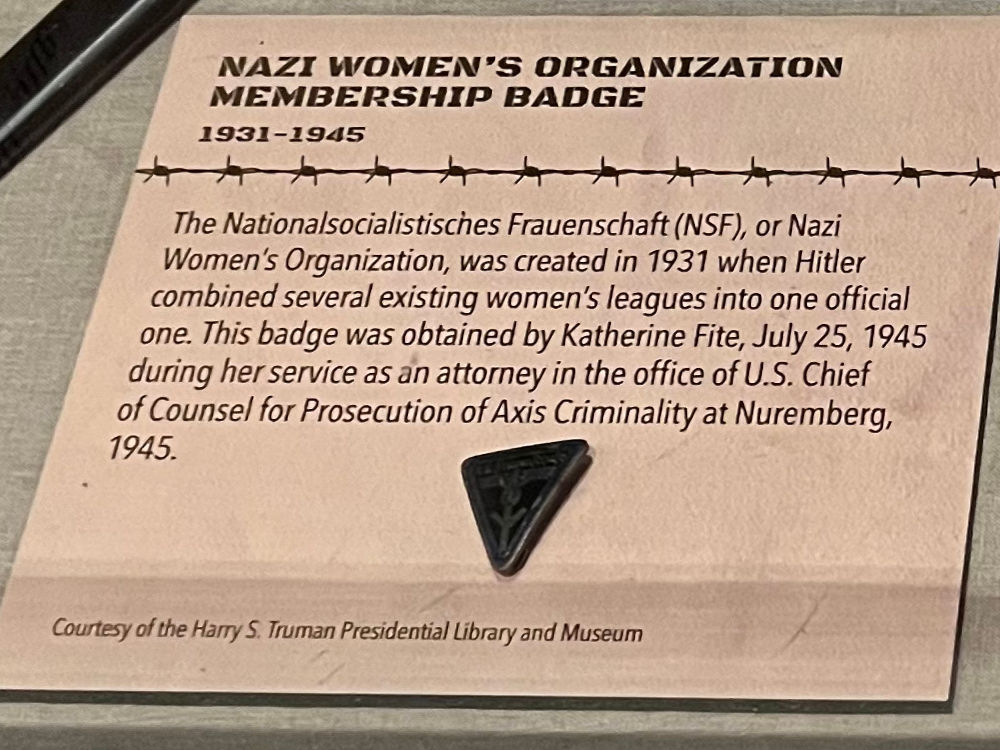
1931-1945
The Nationalsocialistisches Frauenschaft (NSF), or Nazi Women's Organization, was created in 1931 when Hitler combined several existing women's leagues into one official one. This badge was obtained by Katherine Fite, July 25, 1945 during her service as an attorney in the office of U.S. Chief of Counsel for Prosecution of Axis Criminality at Nuremberg, 1945.
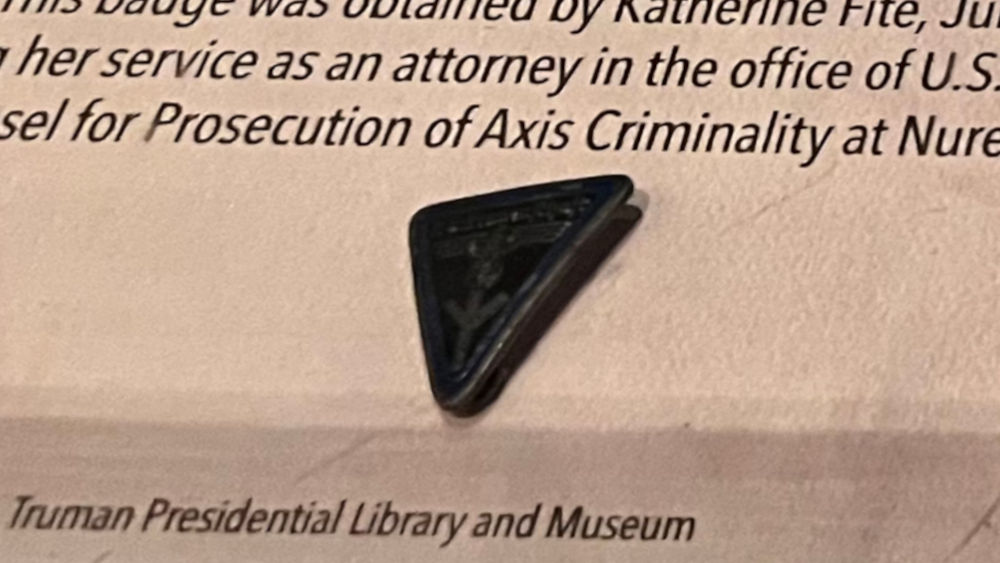
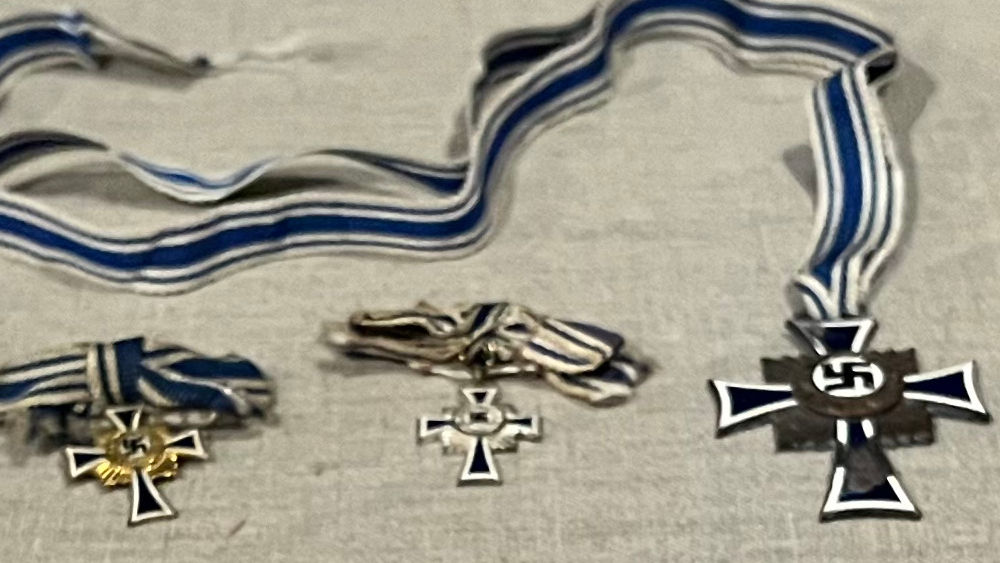
Gold, Silver, and Bronze Classes
The Cross of Honor of the German Mother Bronze Class was given for having four or five children, the Silver for six or seven, and the Gold for eight or more. The bronze cross displayed here was awarded to Johanna Angenendt of Oberhausen.
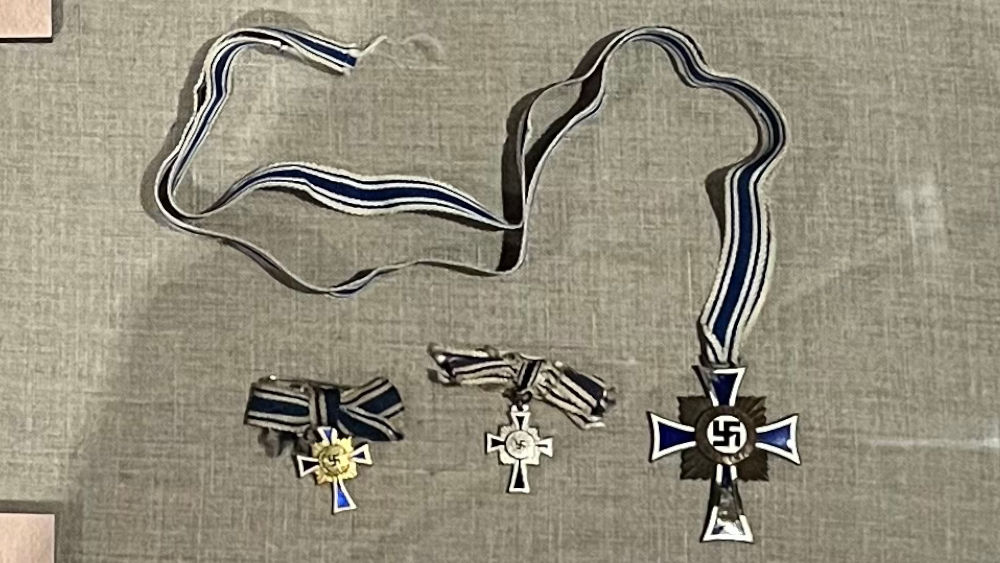
WIKIPEDIAThe Hitler Youth
Was the youth organization of the Nazi Party in Germany. Its origins date back to 1922 and it received the name Hitler-Jugend, Bund deutscher Arbeiterjugend ("Hitler Youth, League of German Worker Youth") in July 1926.From 1936 until 1945, it was the sole official boys' youth organization in Germany and it was partially a paramilitary organization. It was composed of the Hitler Youth proper for male youths aged 14 to 18, and the German Youngsters in the Hitler Youth (Deutsches Jungvolk in der Hitler Jugend or "DJ", also "DJV") for younger boys aged 10 to 14.
With the surrender of Nazi Germany in 1945, the organization de facto ceased to exist. On 10 October 1945, the Hitler Youth and its subordinate units were outlawed by the Allied Control Council along with other Nazi Party organizations. Under Section 86 of the Criminal Code of the Federal Republic of Germany, the Hitler Youth is an "unconstitutional organization" and the distribution or public use of its symbols, except for educational or research purposes, is illegal.
World War II
On 15 August 1939, a fortnight before the beginning of World War II, Schirach agreed with General Wilhelm Keitel that the entire Hitler Youth leadership must have "defence training".May 1, 1940
Artur Axmann was appointed deputy to Schirach, whom he succeeded as Reichsjugendfuhrer of the Hitler Youth on 8 August 1940. Axmann began to reform the group into an auxiliary force which could perform war duties. The Hitler Youth became active in German fire brigades and assisted with recovery efforts to German cities affected by Allied bombing. The Hitler Youth also assisted in such organizations as the Reich postal service, the Reich railway services, and other government offices; members of the HJ also aided the army and served with anti-aircraft defense crews.In 1942
Hitler decreed the establishment of "Hitler Youth defense training camps", led by Wehrmacht officers. Nazi leaders began turning the Hitler Youth into a military reserve to replace manpower which had been depleted due to tremendous military losses. The idea for a Waffen-SS division made up of Hitler Youth members was first proposed by Axmann to Reichsfuhrer-SS Heinrich Himmler in early 1943. The plan for a combat division made up of Hitler Youth members born in 1926 was passed on to Hitler for his approval. Hitler approved the plan in February and Gottlob Berger was tasked with recruiting. Fritz Witt of SS Division Leibstandarte (LSSAH) was appointed divisional commander.In 1944
The 12th SS-Panzer-Division Hitlerjugend was deployed during the Battle of Normandy against the British and Canadian forces to the north of Caen. Over 20,000 German youths participated in the attempt to repulse the D-Day invasion; while they knocked out 28 Canadian tanks during their first effort, they ultimately lost 3,000 lives before the Normandy assault was complete. During the following months, the division earned a reputation for ferocity and fanaticism. When Witt was killed by Allied naval gunfire, SS-Brigadefuhrer Kurt Meyer assumed command and became the divisional commander at age 33.As German casualties escalated with the combination of Operation Bagration and the Lvov-Sandomierz Operation in the east, and Operation Cobra in the west, members of the Hitlerjugend were recruited at ever younger ages. By 1945, the Volkssturm was commonly drafting 12-year-old Hitler Youth members into its ranks. During the Battle of Berlin, Axmann's Hitler Youth formed a major part of the last line of German defense, and they were reportedly among the fiercest fighters. Although the city commander, General Helmuth Weidling, ordered Axmann to disband the Hitler Youth combat formations, in the confusion this order was never carried out. The remnants of the youth brigade took heavy casualties from the advancing Russian forces. Only two survived.
In 1945
There were various incidents of Hitler Youth members shooting prisoners, participating in executions, and committing other wartime atrocities.
WIKIPEDIAThe National Socialist League of the Reich for Physical Exercise
Nationalsozialistischer Reichsbund fur Leibesubungen (NSRL)
Was the umbrella organization for sports and physical education in Nazi Germany. The NSRL was known as the German League of the Reich for Physical Exercise (German: Deutscher Reichsbund fur Leibesubungen, abbreviated DRL) until 1938. The organization was expanded to Austria after that country's annexation by Nazi Germany.The NSRL was led by the Reichssportfuhrer, who after 1934 simultaneously presided over the German National Olympic Committee.
The Deutscher Reichsbund fur Leibesubungen (DRL) was established on 27 July 1934 as the official Sports governing body of Nazi Germany. It would quickly become a formidable system within the German nation.
After the DRL's foundation all other German sport associations gradually lost their freedom and were co-opted into the DRL as mere units ("Fachamter"). Even the most prestigious ones, like the German Football Association (DFB) lost their independence. Von Tschammer's goal was to build a formidable Nazi sports body to which all German sports associations would be submitted. His vision was that physical exercise would "improve the morale and productivity of German workers" as well as making sports a source of national pride for the Germans. Sporting skills were made a criterion for school graduation as well as a necessary qualification for certain jobs and admission to universities. Among the controversial measures taken by the Sports Office of the Reich at the time, the staging of the massive Reichssportfest event on Trinity Sunday was a decision that shocked devout Catholics.
In 1935 journalist Guido von Mengden, was named public relations officer of the Reich Sports Office. He became the personal advisor and consultant of the Reichssportfuhrer in 1936, and subsequently became the chief editor of NS-Sport, the official organ of the Reich Sports Office. Other DRL/NSRL publications included Dietwart, a sports magazine with excellent illustrations and Sport und Staat (Sports and State), a massive four-volume Nazi propaganda report on the organized sports activities in Nazi Germany. Sport und Staat was made by Arno Breitmeyer and Hitler's personal photographer Heinrich Hoffmann. This lavishly illustrated work had many pictures and information about the various Nazi organizations, i.e. SA, NSKK, Bund Deutscher Madel, Hitler Jugend, etc. Printed in 1934 by the publishing house of the German Sports Aid Funds, a branch of the DRL, only volume one and two of a planned series of four volumes were published.
The aims of the promotion of sports in Nazi Germany included hardening the spirit of every German as well as making German citizens feel that they were part of a wider national purpose. This was in line with the ideals of Friedrich Ludwig Jahn, the "Father of physical exercises", who connected the steeling of one's own body to a healthy spirit and promoted the idea of a unified, strong Germany. A more controversial aim was the demonstration of Aryan physical superiority.
Von Tschammer's impressively staged events of sports pageantry not only enhanced the physical activity, but also the nationalism of Germans. Nordic aesthetic beauty and commitment to Germanic ideals of race went hand in hand during the Nazi era, and von Tschammer und Osten implemented a policy of racial exclusion within sports. Athletes of Jewish origin were excluded from participation in relevant sporting events.
WIKIPEDIAThe National Socialist Women's League
Nationalsozialistische Frauenschaft (NS-Frauenschaft)
Was the women's wing of the Nazi Party. It was founded in October 1931 as a fusion of several nationalist and Nazi women's associations, such as the German Women's Order (German: Deutscher Frauenorden, DFO) which had been founded in 1926. From then on, women were subordinate to the NSDAP Reich leadership. Guida Diehl was its first speaker (Kulturreferentin).The Frauenschaft was subordinated to the national party leadership (Reichsleitung); girls and young women were the purview of the League of German Girls (Bund Deutscher Madel, BDM). From February 1934 to the end of World War II in 1945, the NS-Frauenschaft was led by Reich's Women's Leader (Reichsfrauenfuhrerin) Gertrud Scholtz-Klink (1902–1999). It put out a biweekly magazine, the NS-Frauen-Warte.
Its activities included instruction in the use of German-manufactured products, such as butter and rayon, in place of imported ones, as part of the self-sufficiency program, and classes for brides and schoolgirls. During wartime, it also provided refreshments at train stations, collected scrap metal and other materials, ran cookery and other classes, and allocated the domestic servants conscripted in the east to large families. Propaganda organizations depended on it as the primary spreader of propaganda to women.
The NS-Frauenschaft reached a total membership of 2 million by 1938, the equivalent of 40% of the total party membership.
WIKIPEDIAThe Cross of Honour of the German Mother
Ehrenkreuz der Deutschen Mutter, Mutterehrenkreuz, Mutterkreuz
Was a state decoration conferred by the government of the German Reich to honor a Reichsdeutsche German mother for exceptional merit to the German nation. Eligibility later extended to include Volksdeutsche (ethnic German) mothers from, for example, Austria and Sudetenland, that had earlier been incorporated into the German Reich.The decoration was conferred from 1939 until 1945 in three classes: bronze, silver, and gold, to Reichsdeutsche mothers who exhibited probity, exemplary motherhood, and who conceived and raised at least four children in the role of a parent.
Various privileges were bound to honor, one example being preferential treatment, precedence and priority service within society and public services. As one recount recalls "...they were always given the best of everything: housing, food, clothing, and schooling for their children. Old people even had to give up their seats on the bus or streetcar. They were treated like royalty with the greatest respect. No standing in line for them. At the butcher's shop, the best cuts of meat would go into their baskets. A helper or nurse was assigned by the government to help them take care of the brood and arrived first thing in the morning". An annuity was also considered for a recipient mother of the decoration, but due to government budget constraints, this proved unworkable. Members of the Hitler Youth organization were also instructed; a wearer of the Mother's Cross was to be honorably greeted (saluted) when encountered. The Volkischer Beobachter (People's Observer) national newspaper (1938 Issue No. 25) stated: "...the holder of the Mother's Cross of Honor will in future enjoy all types of privileges that we by nature have accustomed to our nation's honored comrades and our injured war veterans."
Exact total decorations bestowed throughout its existence are no longer traceable through the limited official records that survived the Second World War, the central application archives held at the Prasidialkanzlei (Presidential Chancellery) in Berlin were lost or otherwise destroyed by closing war events; however, it is estimated that up until September 1941 there were a total of 4.7 million recipient mothers honored with the Mother's Cross decoration.







